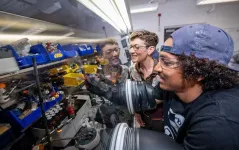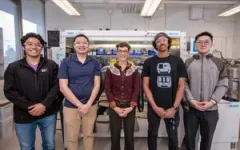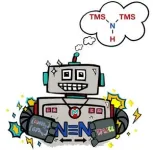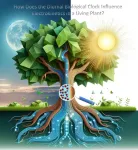A cleaner way to produce ammonia
New research reveals how a surprising catalyst can help to efficiently convert nitrogen into useful products under ambient conditions.
2024-05-28
(Press-News.org)
– By Rachel Berkowitz
Ammonia is the starting point for the fertilizers that have secured the world’s food supply for the last century. It’s also a main component of cleaning products, and is even considered as a future carbon-free replacement for fossil fuels in vehicles. But synthesizing ammonia from molecular nitrogen is an energy-intensive industrial process, due to the high temperatures and pressures at which the standard reaction proceeds. Scientists from the Department of Energy's Lawrence Berkeley National Laboratory (Berkeley Lab) now have a new way to produce ammonia that works at room temperature and pressure.
Since 1909, the industry-wide standard for synthesizing ammonia has involved converting molecular nitrogen (dinitrogen, N2) via a reaction with hydrogen gas using metal-based catalysts, known as the Haber-Bosch process. Polly Arnold, a senior staff scientist and the director of the Chemical Sciences Division at Berkeley Lab, has found that instead, catalysts made from abundant so-called rare-earth metals can facilitate this reaction at room temperature.
“Nobody expected rare earth metals to do this reaction. They’ve expanded our arsenal of potential ambient condition catalysts,” says Arnold, who is also a professor of chemistry at UC Berkeley.
Rare-earth metals are the silvery-white, soft, heavy elements that make up all the non-radioactive metals from the group at the bottom of the periodic table, and have attracted plenty of interest for applications in electronics, lasers, and magnetic materials. “Despite their name, rare-earth metals are not actually rare,” said Anthony Wong, a postdoctoral researcher in Arnold’s group at UC Berkeley and affiliate in Berkeley Lab’s Chemical Sciences Division and lead author on the paper in Chem Catalysis that describes the work. “Some are nearly as common as copper, and their salts are less toxic than metals that are already used in catalysis,” he added.
The exciting thing about rare-earth metals, from a fundamental perspective, is that they have a set of additional electrons that their transition metal counterparts do not have. This gives them interesting opto-magnetic properties – but chemists don’t fully understand if and how the electrons might be used in reactions. Examining reactions involving rare earth metals is an attractive tool for understanding their electronic structures and how their structures can apply to new reactivity.
Rare earths have been known to bind molecular nitrogen since the 1990s. However, until now, researchers have not been able to use them to create nitrogen-functionalized chemicals like ammonia or amines catalytically from N2. Wong, Arnold, and their colleagues designed compounds that joined two rare-earth metals with simple linkages made from phenolates based on a simple antioxidant used widely in food. The resulting structure formed a rectangular cavity. Molecular nitrogen that diffused into the cavity formed bonds with the metals at either end, which activates the gas. Then, electrons introduced into the cavity from a potassium source attacked the activated nitrogen, cleaving its bonds. In all its standard forms, converted nitrogen forms three covalent bonds to hydrogen atoms, or other reactants, resulting in symmetrical ammonia or amines.
“Our catalysts activate and hold the dinitrogen, while different reagents come in and react to form different products,” says Arnold. She intends next to use electrodes instead of the potassium reagent as a source of electrons, since these can be renewable if they derive from solar cells, for example.
The scientists will next explore how to use rare earths to synthesize additional nitrogen-containing products by tuning the shape and size of the letterbox-shaped cavity. “Our next step is to explore and understand which rare-earth metal properties impact the chemistry,” said Wong.
The new process is not going to replace the widespread industrial Haber-Bosch process. Global ammonia production has hovered around 200 million metric tons annually since 2020, and the existing tools are optimized and extremely efficient at large scale. But the process consumes around 2% of the world’s energy use and creates geographic inequities in the availability of ammonia. “That’s not food justice,” said Arnold. Wong added, “we need better ways of producing ammonia that are less energy intensive and can be conducted at ambient temperatures and pressures to help with food and energy security.” Their patented technology could bring fertilizers and chemically specific nitrogen products to regions without a pipeline, and at a much lower cost.
Some of this research was conducted at the Advanced Light Source, a Department of Energy Office of Science User Facility located at Berkeley Lab.
The technology is now available for licensing; contact ipo@lbl.gov.
This research is funded by the Department of Energy’s Office of Science.
###
Lawrence Berkeley National Laboratory (Berkeley Lab) is committed to delivering solutions for humankind through research in clean energy, a healthy planet, and discovery science. Founded in 1931 on the belief that the biggest problems are best addressed by teams, Berkeley Lab and its scientists have been recognized with 16 Nobel Prizes. Researchers from around the world rely on the Lab’s world-class scientific facilities for their own pioneering research. Berkeley Lab is a multiprogram national laboratory managed by the University of California for the U.S. Department of Energy’s Office of Science.
DOE’s Office of Science is the single largest supporter of basic research in the physical sciences in the United States, and is working to address some of the most pressing challenges of our time. For more information, please visit energy.gov/science.
END
ELSE PRESS RELEASES FROM THIS DATE:
2024-05-28
The African turquoise killifish lives in ephemeral ponds in Zimbabwe and Mozambique. To survive the annual dry season, the fish’s embryos enter a state of extreme suspended animation or “diapause” for approximately 8 months. Now, researchers have uncovered the mechanisms that enabled the killifish to evolve this extreme survival state. They report May 30 in the journal Cell that although killifish evolved diapause less than 18 million years ago, they did so by co-opting ancient genes ...
2024-05-28
WASHINGTON, May 28, 2024 —When plants draw water from their roots to nourish their stems and leaves, they produce an electric potential that could be harnessed as a renewable energy source. However, like all living things, plants are subject to a circadian rhythm — the biological clock that runs through day and night cycles and influences biological processes. In plants, this daily cycle includes capturing light energy for photosynthesis and absorbing water and nutrients from the soil during the day and slowing its growth processes at night.
In a study published this week in ...
2024-05-28
About The Study: In this national cross-sectional study of privately insured U.S. families, inflation-adjusted health care spending increased from 2007 to 2019, largely owing to increasing contributions to premiums. Annual financial medical burden increased significantly, both overall and among low-income and higher-income families. Mean financial medical burden was more than 26% of postsubsistence income for low-income families, compared with approximately 6% for higher-income families.
Corresponding ...
2024-05-28
About The Study: The findings of this matched cohort study suggest that women with premenstrual disorders are not at increased risk of early death overall. However, the risk was elevated among young women and for death by suicide. This supports the importance of careful follow-up for young patients and highlights the need to develop suicide prevention strategies for all women with premenstrual disorders.
Corresponding Author: To contact the corresponding author, Marion Opatowski, Ph.D., email marion.opatowski@ki.se.
To access the embargoed ...
2024-05-28
About The Study: The treatment effect of early direct oral anticoagulant initiation did not differ in people with minor, moderate, or major stroke assessed by brain imaging. Early treatment was not associated with a higher rate of adverse events, especially symptomatic intracranial hemorrhage, for any infarct size, including major stroke.
Corresponding Author: To contact the corresponding author, Urs Fischer, M.D., M.Sc., email urs.fischer@insel.ch.
To access the embargoed study: Visit our For The Media website at this link https://media.jamanetwork.com/
(doi:10.1001/jamaneurol.2024.1450)
Editor’s ...
2024-05-28
About The Study: Early-life air and noise pollution exposure were prospectively associated with three common mental health problems (psychotic experiences, depression, and anxiety) from adolescence to young adulthood in this longitudinal cohort study. There was a degree of specificity in terms of pollutant-timing-outcome associations. Interventions to reduce air and noise pollution exposure (e.g., clean air zones) could potentially improve population mental health. Replication using quasi-experimental designs is now needed to shed further light on the underlying ...
2024-05-28
As the planet has warmed, scientists have long been concerned about the potential for harmful greenhouse gasses to seep out of thawing Arctic permafrost. Recent estimates suggest that by 2100 the amount of carbon dioxide and methane released from these perpetually frozen lands could be on par with emissions from large industrial countries. However, new research led by a team of Colorado State University microbiome scientists suggests those estimates might be too low.
Microorganisms are responsible for the process that will generate greenhouse gasses from thawing northern peatlands, which contain about ...
2024-05-28
Feeding children peanut products regularly from infancy to age 5 years reduced the rate of peanut allergy in adolescence by 71%, even when the children ate or avoided peanut products as desired for many years. These new findings, from a study sponsored and co-funded by the National Institutes of Health’s National Institute of Allergy and Infectious Diseases (NIAID), provide conclusive evidence that achieving long-term prevention of peanut allergy is possible through early allergen consumption. The results were published today in the journal NEJM Evidence.
“Today’s findings should reinforce parents’ and caregivers’ ...
2024-05-28
Tsukuba, Japan—The nucleus accumbens plays a pivotal role in motivational behavior and sleep regulation, modulated by adenosine A2A receptors (A2AR). Hence, selective A2AR regulation within this brain region could control sleep and motivation. However, A2ARs are distributed across various organs, including the heart, posing challenges for precise brain-specific modulation without genetic interventions.
A research team led by Professor Michael Lazarus and Associate Professor Tsuyoshi Saitoh (TRiSTAR Fellow) from the Institute of Medicine and the International Institute for Integrative Sleep Medicine (WPI-IIIS) at the University ...
2024-05-28
SAN ANTONIO — May 28, 2024 —Southwest Research Institute has created a comprehensive data analysis tool to help metropolitan areas curb urban heat islands (UHIs) and pursue mitigation methods for especially vulnerable populations. This internally funded project was a collaboration with the City of San Antonio.
UHIs occur when dense concentrations of pavement and buildings absorb heat and raise surrounding temperatures. Without green spaces to provide a cooling effect, UHI temperatures can exceed other areas by as much as 20 degrees Fahrenheit, which could be dangerous to residents during summer.
“Tackling UHIs goes ...
LAST 30 PRESS RELEASES:
[Press-News.org] A cleaner way to produce ammonia
New research reveals how a surprising catalyst can help to efficiently convert nitrogen into useful products under ambient conditions.






